
The 2014 NAMM Show was another great year for the event – the weather was fantastic, there were tons of new synths and interesting gear introduced and we got to see a lot of people passionate about synths and electronic music.
Here’s our pick of the best new gear that was either introduced at the show this year or that made its NAMM debut this year:
The Best Of The 2014 NAMM Show
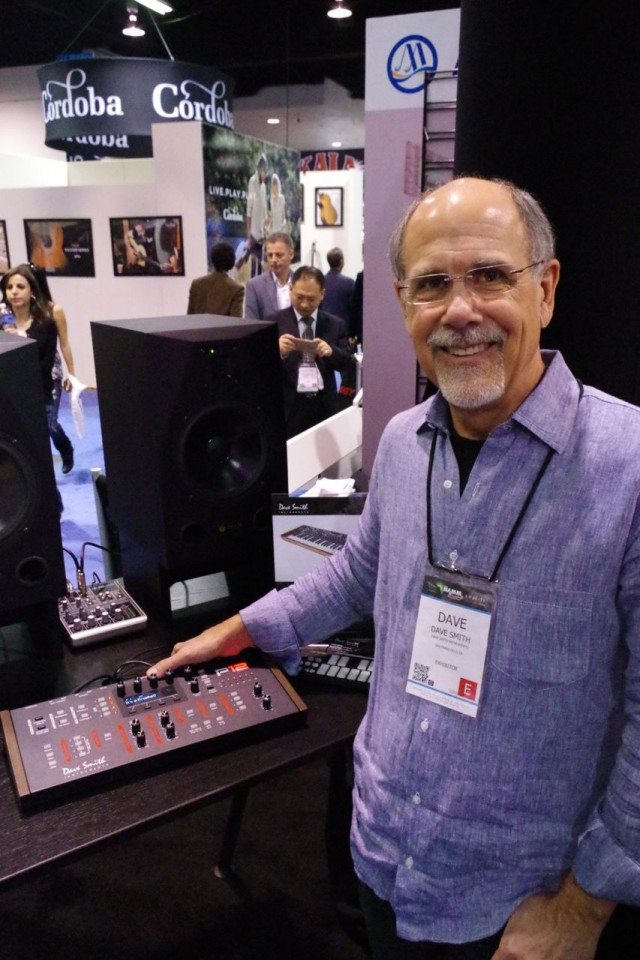
Dave Smith’s new synthesizer, the Prophet 12 Desktop, sounds great and is surprisingly immediate, proving that usability isn’t just a function of how many knobs a synth has.
And the Prophet 12 Desktop is exactly what a lot of readers asked for when he introduced the Prophet 12 last year – a version for people that already have a great control keyboard.
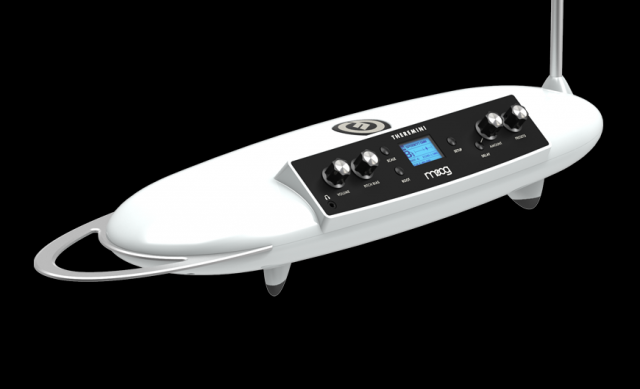
Moog’s new Sub 37 is going to be an amazing synth – but the Moog Theremini impressed us even more.
The Moog Theremini is the biggest rethinking of the theremin in the instrument’s history. It’s daring aesthetically, disposing with the traditional dark wood and metal of most of Moog’s instruments and instead looking like something out of Barbarella. It’s daring creatively, turning the theremin into a basic synthesizer, with a wavetable oscillator design inspired by Animoog. And it’s daringly playable, offering to at last turn the theremin into an instrument that skilled players can play both consistently in tune and expressively.
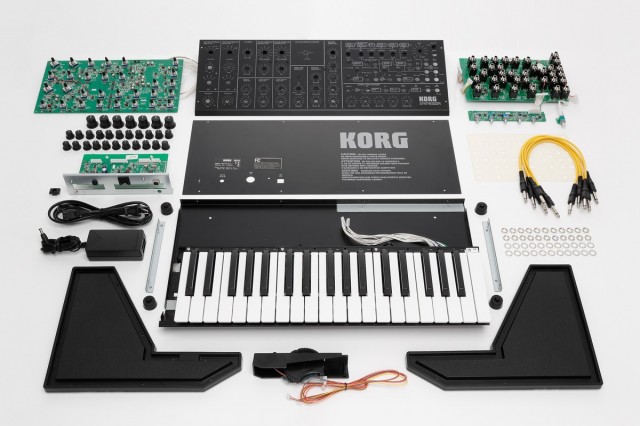
Korg made a surprising introduction at the Winter NAMM Show – a full size version of the classic Korg MS-20, in kit form.
The MS-20 Kit, above, is a true analog, 1:1 scale reissue of the MS-20, with both filters built in (the more aggressive early production filter and more mellow late production one).
Development of the MS-20 Kit was led by the original engineers themselves, who, according to Korg, spared no effort to perfectly replicate the circuitry of the original unit. When it was necessary to substitute a part, the engineers made the decision which part to use, based on their own ears, ensuring that the sound of the original unit has been reproduced.
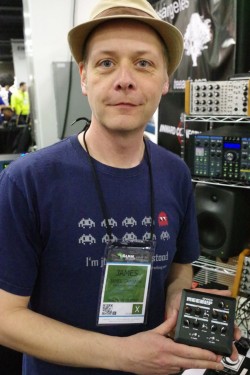
The Meeblip Anode, shown at right with developer James Grahame, is a tiny hybrid synth that has a lot going for it:
- Dual oscillators
- Analog Filter
- LFO
- It’s open source hardware
- It sounds pretty bad-ass
As with the original MeeBlip, the anode is open source, and users are encouraged to learn from, and experiment with, its code and circuits. The anode comes fully pre-assembled, though, and is ready for use straight out the box.
And it costs $125 – which is pretty amazing for a MIDI bass synthesizer.
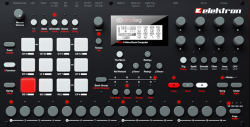 The Elektron Analog Rytm is a new eight-voice analog drum machine.
The Elektron Analog Rytm is a new eight-voice analog drum machine.
Eight analog drum voices take advantage of several dedicated analog circuit designs, each of them designed for generating specific types of analog drum sounds. For even more percussive flexibility, each voice can also be augmented up with user samples.

Keith McMillen Instruments Softstep 2 – with the SoftStep 2, McMillen decided to redesign the MIDI pedal controller from the ground up, giving it improved playability, increased memory, state recall, brighter LED lighting and ‘beer-proof’ design.
Don’t you wish all your gear was ‘beer-proof’?
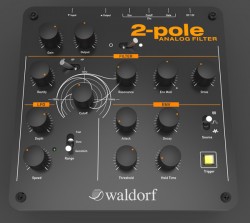
Waldorf introduced the 2-Pole filter, a new hardware analog filter that’s designed to give users ‘the heart of the Waldorf sound’ in an easy to use, one-knob per function design.
It’s not just a powerful analog filter, though, it’s one of the most flexible and capable filters that we’ve ever seen. It’s got a built-in preamp, which doubles its flexibility. It can be modulated by its LFO, envelope follower or an external signal. It’s got post-filter overdrive and, what may be a first for electronic music gear, a gemütlich setting.
Most importantly, though, the 2-Pole sounds great.
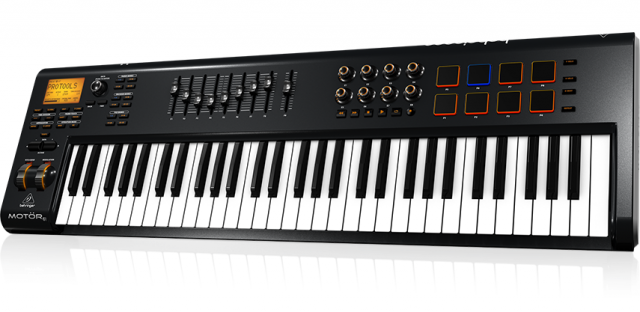
Behringer has long been known for making inexpensive versions of established gear designs. For several years, though, it’s been putting more emphasis on developing its own innovative designs.
A great example of this is the Behringer Motör MIDI controllers, which offers all the controls we’ve grown to expect from MIDI control keyboards – plus motorized faders and DAW support.
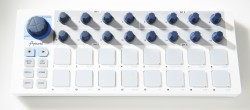 Another new MIDI controller that impressed show-goers with its combination of features and affordable pricing is the Arturia BeatStep. The Beatstep is a versatile pad and knob MIDI controller.
Another new MIDI controller that impressed show-goers with its combination of features and affordable pricing is the Arturia BeatStep. The Beatstep is a versatile pad and knob MIDI controller.
But it also packs a built-in step sequencer and control voltage outputs, meaning that it doubles as a step sequencer for your analog gear.
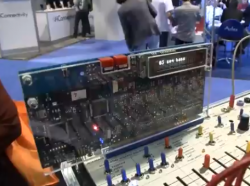
Something we never expected to see was a new Wifi card for the 40-year old Music Easel – but that’s what Buchla introduced with the iProgram.
The iProgram is a new expansion card for the Music Easel that brings patch memory and WiFi connectivity – and even iPad control – to the vintage analog modular synth design.
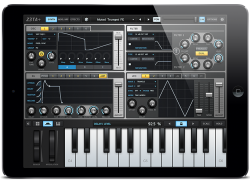 Cakewalk surprised a few people by introducing an iPad version of their flagship software synthesizer Z3TA+ 2.
Cakewalk surprised a few people by introducing an iPad version of their flagship software synthesizer Z3TA+ 2.
Existing Z3TA+ 2 users know how powerful the synth app is. The iPad version promises to open up new options and workflows for existing users – and to introduce the Z3TA+ design to a lot of new users.
 The coolest news for mobile music makers, though, was probably AudioBus 2, which was informally introduced at the show.
The coolest news for mobile music makers, though, was probably AudioBus 2, which was informally introduced at the show.
AudioBus 2 will be capable of running as many apps in parallel or in series as your device can handle – multiple, independent pipelines with as many inputs, filters or outputs as you like in each.
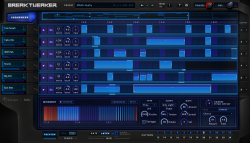 iZotope Break Tweaker – designed by BT (the producer behind Stutter Edit) in collaboration with iZotope in-house designer-musicians, Break Tweaker is a described as ‘futuristic drum sculpting and beat sequencing machine.’
iZotope Break Tweaker – designed by BT (the producer behind Stutter Edit) in collaboration with iZotope in-house designer-musicians, Break Tweaker is a described as ‘futuristic drum sculpting and beat sequencing machine.’
Looking beyond the effusive marketing-speak, Break Tweaker is a new software drum machine with some crazy technical features, including: beat editing at tremendously fine resolution; advanced features for creating polyrhythmic and isorhythmic rhythms; a deep sample + synthesis drum synth engine; and deep MIDI controlled beat mangling.
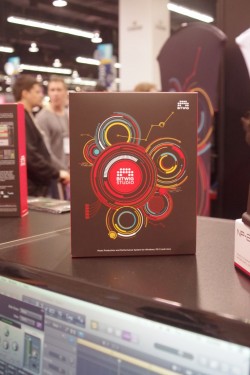 Bitwig Studio – after alternately exciting and frustrating electronic musicians over the last year, Bitwig came to NAMM to show the release version of their new DAW and to announce the ship date – March 26th, 2014.
Bitwig Studio – after alternately exciting and frustrating electronic musicians over the last year, Bitwig came to NAMM to show the release version of their new DAW and to announce the ship date – March 26th, 2014.
They also highlighted many of the features that originally excited people about Bitwig, including:
- Cross platform support (Windows, Mac OS X, Linux);
- Deep multi-core and multi-processor support;
- Built-in 32/64-bit bridging;
- Plugin-crash-protection;
- Multi-display support;
- The ability to open multiple projects at once:
- 50 included devices; and
- An open controller API.

Two words: Wireless Keytar.
Alesis introduced the Vortex Wireless, a $199 wired/wireless keytar controller. Plug the included USB receiver dongle into any Mac or PC to establish a live USB/MIDI link with the Vortex controller and you’re ready for keytar action.
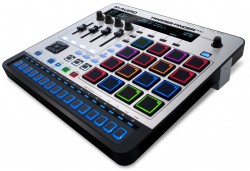 M-Audio Trigger Finger Pro – the original Trigger Finger was pretty cool, but the new Pro version takes the concept to a new level. It’s a 4×4 pad controller, but it’s also got a built-in step sequencer and hardware MIDI out.
M-Audio Trigger Finger Pro – the original Trigger Finger was pretty cool, but the new Pro version takes the concept to a new level. It’s a 4×4 pad controller, but it’s also got a built-in step sequencer and hardware MIDI out.
And then there are the Trigger Finger Pro’s 48 assignable controls and the integrated software package.
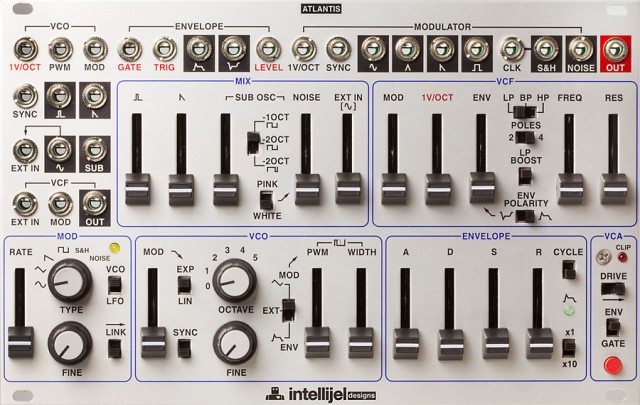
When it comes to Eurorack synthesizer modules, there was an amazing amount of new gear introduced. There was so much new Euro gear that it’s almost impossible to pick a ‘best of’ out of the bunch.
So, we’ll cheat and share two of our favorites. The new Intellijel Atlantis, above, is a complete, fully patchable subtractive synth voice in Euro format. For situations where you want a straightforward synth voice, patch in a CV & gate and you’re ready to go. But it’s also fully modular, so you can patch more experimental sounds or patch the Atlantis core elements into other modules.
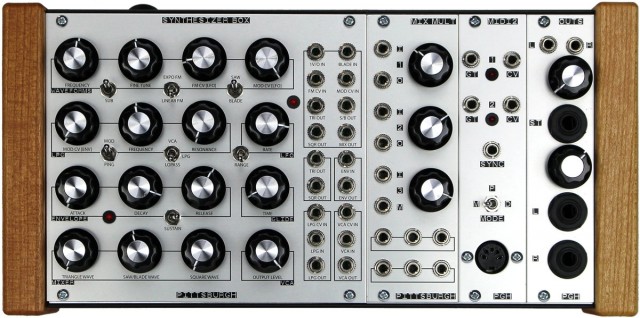
We were equally impressed by the Pittsburgh Modular System 10 – one of three all-in-one Eurorack modular synths that they introduced at the show. It’s an all-in-one synth that works like a standard monosynth, but also is a starter Eurorack system.
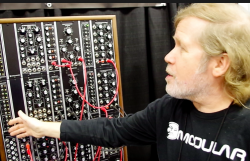 For large format synth fans, Gert Jalass of Moon Modular showed that there’s lots of room for innovation in the 5U format.
For large format synth fans, Gert Jalass of Moon Modular showed that there’s lots of room for innovation in the 5U format.
He showcased an insanely powerful system that featured a combination of his existing modules and new modules, like his M524 Quad Low Frequency Oscillator. The Moon Modular system offers the proven usability and sound of a big Moog modular system, but also includes features that would have been impossible or impractical in the early days of modular synths.
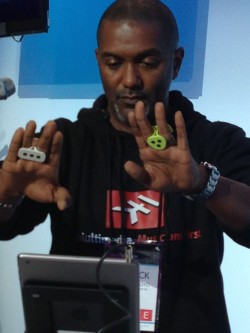 IK Multimedia’s iRing – iRing is a $25 device that works with your iOS device to work as a motion-tracking controller for music.
IK Multimedia’s iRing – iRing is a $25 device that works with your iOS device to work as a motion-tracking controller for music.
The iRing controller utilizes wearable rings with identifiable markers, along with your mobile device’s front-facing camera, to determine the precise positioning of the ring markers, tracking their movements and position in the 3-dimensional space in front of the device. And that’s pretty cool.
But what really makes iRing interesting, though, is not that it’s a new option for 3D motion control for musicians – it’s that:
- IK managed to make it not just inexpensive, but cheap; and
- IK is freely offering a software development kit that lets anyone incorporate support for the iRing into their apps.
We’re looking forward to seeing what music hackers do with this.
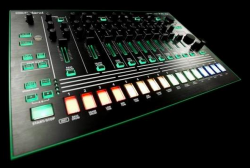 The Roland Aira line of electronic music gear managed to generate the biggest buzz of the Winter NAMM Show, despite the fact that no details were officially released.
The Roland Aira line of electronic music gear managed to generate the biggest buzz of the Winter NAMM Show, despite the fact that no details were officially released.
At Roland’s official press event, they introduced the new Aira brand as a sort of start up within the company.
We expect the Aira line to have a lot of people talking when it gets its official introduction, later this year.
Novation and Arturia also were both showing analog synths, the Bass Station 2 and the Microbrute. The two analogs weren’t new announcements, but deserve mention as notable new synths that made their NAMM debut this year.
Also, because there were too many interesting new synths to include in this already-long article, you might want to also check out our story about new analog synths at The 2014 NAMM Show.
What did you think of the gear introduced at this year’s NAMM Show? Let us know what you think of our Best of NAMM picks – and what you were most impressed by!

Roli Seaboard, I loved it soo much I preordered the stage version. With practice it promises a new way to Control sound
Maybe you should learn how to play instead of relying on a controller.
That comment was not just rude, but ignorant.
Any synthesist that’s played an instrument with poly aftertouch knows what a cool feature it is. Unfortunately, poly aftertouch has been so hard to find that people have got used to keyboards that are great for pianists, but very limiting for synthesists.
Put a classically trained pianist behind any keyboard or synth, with or without aftertouch, and he will create sound/music and expression no combination of controllers could produce.
I’ve seen a lot of people claiming this was an underwhelming NAMN, but I was greatly surprised by a couple of revelations this year.
1) Wow, there are a lot of Roland fans out there. The butt-hurt was strong in YouTube comments for anything that might be a competitor to the Airas. I wouldn’t have thought that Roland would have this many fans these days. When is the last time they released anything interesting? Corporate tribalism/fanboism is always a mystery to me, but this was particularly puzzling.
2) I don’t think guitarists know how sound works. There are some ludicrous “inventions” being thrown at these guys by snake-oil salesman. That $6,000 guitar cable was particularly full of shit, with mock-up diagrams showing how sound waves are messed up when you use anything less than it for recordings. I mean really, no one who has ever recorded a synth playing a square wave would be fooled by their con.
I thought it was a great NAMM – people are jaded if they don’t think the new MS-20 is cool, the Murmux synths or the Pittsburgh Modular synths.
From comments I’ve seen, the gap may be that people want a cheap polysynth – and by cheap I mean under $1000.
The only other downside I saw to this year’s show was that I wasn’t that excited about the software. It seems like attention has moved to mobile music making, though, and it doesn’t seem like it’s that important to mobile developers to introduce at NAMM.
I’m a guitarist and I know enough not to fall for dumb hype like that, but then again I like synths too, obviously or I wouldn’t be here.
It’s nice to have a full size MS-20 reproduction, very cool, I just don’t get why it’s a kit. It’s not a PC board that you have to solder, it all just snaps/screws together. And its twice the price of the mini. Is it to make it easier to ship? So that Korg don’t have to honor warranties by saying someone screwed up the assembly? I’m grasping at straws here, someone help me out…
you actually just touched on the whole reason i originally intended to comment on this thread. besides bitwig studio, i dont really recall hearing about *any* significant software releases from anyone. Was it just lackluster announcements, a lack of coverage, or are manufacturers just moving away from the software arena and going to low-cost “toy” type products (not calling them toys as a slight, that’s just the general term i use for these small keyboard, dinky module boxes, but cheap and/or small does not automatically equal bad)
with companies like arturia and sounddamage moving from the software realm into hardware, it makes me wonder how prevalent this is.
When people diss Roland, I laugh a bit. I don’t know what they think they are missing, but the Roland gear I’ve owned and used has always been solid. IMO, they have too “clean” a sound at times, but I’ve hit many sweet spots by adding another layer or effecting a sound a bit more. When you can take up a tool and find yourself simply working steadily because it functions well, isn’t that a desirable end goal, if not THE end goal? To have a productive result to our dabblings? Don’t equate Volca-like novelty with the more subtle stability of a Roland. Those are different qualities that serve different purposes. After all, the HandSonic drum has remained in production for about 20 YEARS. Talking smack about a company that manages things like that is quaint at best. Let’s debate the fine points rather than acting like any synth company is an unwelcome, drunken relative who pissed the couch, eh?
I’m afraid you’ve missed my point, while proving it, Fungo.
I’m not “dissing” Roland. I’m questioning the bizarre behaviour of Roland fans in their defence. I’m not talking about anyone directly (or even indirectly) shitting on Roland either. I’m taking about all the YouTube comments on Elektron RYTM videos from rabid Roland fans.
I just don’t get that sort of brand loyalty at all, but I especially don’t get it in the case of Roland. This sort of behaviour is usually reserved for children fighting over Xbox vs PlayStation, and I can’t imagine what Roland have done recently to inspire the same zeal in this new generation.
Moog is perhaps the closest personal affinity and affiliation I have. I love my Minitaur, I love Animoog, I’ve worked for them on a tiny contractual basis. But I still call them on their shit. Nothing is sacred. I was one of the loudest voices in protest over their MIDI Tax in Animoog.
I certainly wouldn’t go out of my way to troll other manufacturer’s videos to say they don’t stack up to the new hotness from Moog.
WRT point 1 –
I think this idea that Roland deserves a kick in the ass comes from instrument tunnel vision. Roland isn’t primarily a keyboard/module synth maker anymore. Go to your preferred internet instrument supplier and type just “Roland” into the search bar and see what comes up. Electronic drum kits (Most often the cream of the crop), digital hand percussion, field recorders, digital pianos, accordians, combo amps, stage monitors, digital video mixers, etc. etc. I don’t think Roland is shaking in their boots because the synth-nerds are still waiting (spelled: “bitching madly”) for something “innovative.”
Now type in Korg – you get synths, instrument tuners, and midi controllers (mostly cheap midi controllers). The end. Also, nothing truly innovative has come from Korg at all. There is nothing new about the Volcas or Monotr— series aside from size and price-point. And in reality, small DIY companies were already doing it before them. It’s not innovation, its a pendulum swing in favor of analogue. That’s all.
I think the real butt-hurt is with the people who expect Roland to jump just because 1000 comments on Synthtopia asked them to.
oh no, I took the Korg’s name in vein
Tim
The Roland FA-08 looks like a beast, but is more for performers than producers or people that want to experiment with sound design.
Also – the Aria TR-8 looks like it’s going to be a killer drum machine. I don’t expect it to be competing with Dave Smith’s Tempest, but with mainstream drum machines. Based on the video previews, it sounds way better than the Electribe ER, which makes sense, since the ER is basically a 10-year old design.
Having used an Integra-7 extensively over recent months I can guarantee you that those who dig into the SN-S Engine will find more than enough meat for experimenting with sound design.
I’ve replaced both the D550 & JD990 since getting it and it is capable of some rather complex sound design on its own and/or layered with SN-A voices too. There is no reason why someone could not get very creative with the FA-08 if they where so inclined.
I get lots of use out of the Triton Pro still – expand the sample ram and throw in a moss board and it is an incredibly creative tool (for example).
That said they aren’t my only studio tools but the new Roland FA packs a lot of sound design punch in a well priced package and can easily do anything a JD800 and D50 could quite easily if the Integra-7 engine is anything to go by.
ten bucks says there’s some dude on gearslutz right now calling anyone without a $6000 cable a noob.
The imperssion I got from alesis is that they are going to release a ton of products, I was surprised by that.
I think last year’s NAMM was a hard act to follow. I’ve also noticed that people have combined NAMM with Musikmesse when recollecting 2013. I’ve seen it mentioned by a few people that the volcas were released at NAMM last year, which wasn’t the case. Musikmesse last year was also incredibly strong, which made for a great year, so I can understand where the confusion and unfair comparisons are coming from. That said, I’m looking forward to Musikmesse this year. It’s just around the corner.
This year’s NAMM blows last year’s out of the water! It’s hard to beat twenty new analog synths!
Last year, the coolest new synth was the MS-20 Mini. This year, there were a half dozen new synths (from Korg, Moog, Freaqbox, novation,etc) introduced that are as good or better.
The question is which to buy and where to get the money?
while the ms-20 mini was definitely up there and a very important release for us nerds, I thought the music easil and the prophet 12 were more exciting.. I think the products released in 2013 were a little riskier, as a few of the new synths this year were improving upon previous products, and a few others were released well before NAMM.
What the hell happened to Yamaha this year?
word on the street is they are scaling back their keyboard/synth stuff big time
Note that Alesis would not actually demo Vortex wireless midi functionality. Belive it when you see it. Starr Labs, on the other hand, bravely demo’d wireless midi over 125 ft. right on the NAMM floor!
Thanks for including iRing. It will also work with the front camera too, if you don’t need to see the screen (definitely some applications for that use case) or (more likely) you have the screen output elsewhere. http://www.ikmultimedia.com/iring
Edit – I meant the main camera (NOT just the front-facing camera) for iRing
Roland sucks…nothing cool about that company at all…They used to be one of the best. If you like boring home pianos and lame digital synths from the 90’s then they are truly #1!
The BSII debuted at NAMM last year as an unfinished prototype, didn’t it?
Also, I’m surprised Korg’s Gadget app didn’t make the list.
Maybe these don’t qualify as being among the “best”, but they are noteworthy and were introduced without much fanfare.
Roland demonstrated their new Handsonic, which lacks some of the features of the previous models, but offers USB.
Akai displayed their new EWI, which combines USB with gigabytes of onboard sounds.